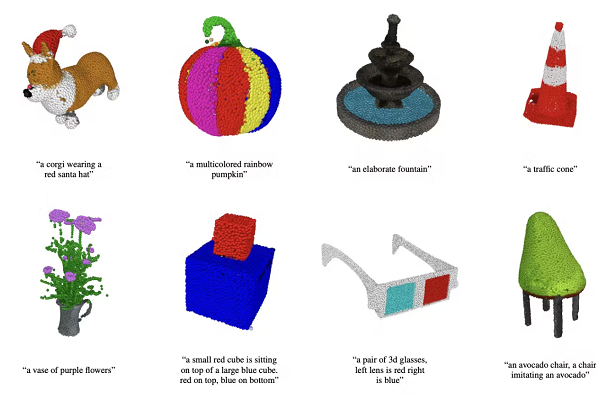OpenAI Debuts Text-to-3D Model AI Tool Point-E
 OpenAI has entered a new dimension of synthetic media by introducing Point-E, a generative AI tool that can produce three-dimensional objects from text prompts. The open-source machine learning model uses AI to design the objects in just a minute or two, hence the E for efficiency, albeit with some notable limitations compared its flatter cousin DALL-E.
OpenAI has entered a new dimension of synthetic media by introducing Point-E, a generative AI tool that can produce three-dimensional objects from text prompts. The open-source machine learning model uses AI to design the objects in just a minute or two, hence the E for efficiency, albeit with some notable limitations compared its flatter cousin DALL-E.
Point-E 3D
Point-E essentially augments the increasingly common text-to-image AI models with a third dimension. The AI processes a text prompt to create an image, then applies a different AI model trained on a dataset of millions of images and their 3D counterparts, just as Stable Diffusion or DALL-E are trained to understand the link between a word and what it means visually. But, the AI tackles the task by plotting a swarm of data points in a virtual cloud rather than the relatively solid design a human might create with standard digital tools.

The point cloud approach acts as a shortcut toward finishing the model and takes less computational power. 3D modeling currently can take many hours or days, depending on the complexity. On the other hand, Point-E’s objects often come out somewhat fuzzy and missing details in shape and texture. Point-E attempts to overcome that flaw by embedding the point cloud in a mesh to solidify the edges and planes of the object, but that sometimes leads to a different flavor of errors with flattened or incomplete objects. Still, the potential value of AI-generated 3D models means there will likely be a rush of interest and experimentation, just as with the generative text and image options mushrooming today. OpenAI has already begun staking a claim in more varied uses of synthetic media that might benefit from 3D models, including the OpenAI Startup Fund leading a $50 million investment in video editing AI startup Descript last month.
“In this work, we focus specifically on the problem of text-to-3D generation, which has significant potential to democratize 3D content creation for a wide range of applications such as virtual reality, gaming, and industrial design,” OpenAI’s researchers explained in a new academic paper on Point-E. “While our method performs worse on this evaluation than state-of-the-art techniques, it produces samples in a small fraction of the time. This could make it more practical for certain applications, or could allow for the discovery of higher-quality 3D objects by sampling many objects and selecting the best one according to some heuristic.”
Follow @voicebotaiFollow @erichschwartz
‘South Park’ Creators Raise $20M for Synthetic Media Startup Deep Voodoo
‘AI Howie Mandel’ by DeepBrain AI Joins Growing Cast of Synthetic Celebrities








